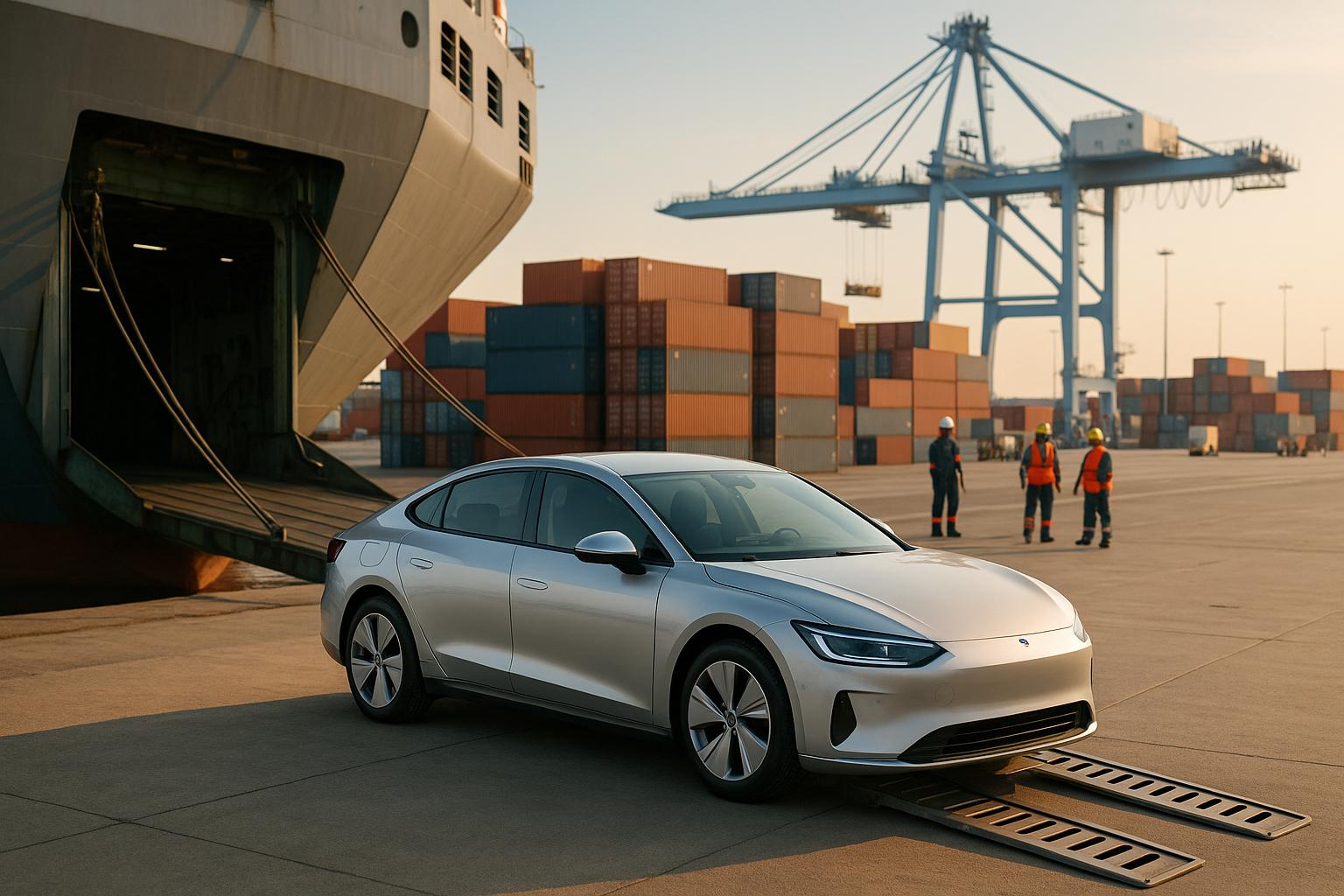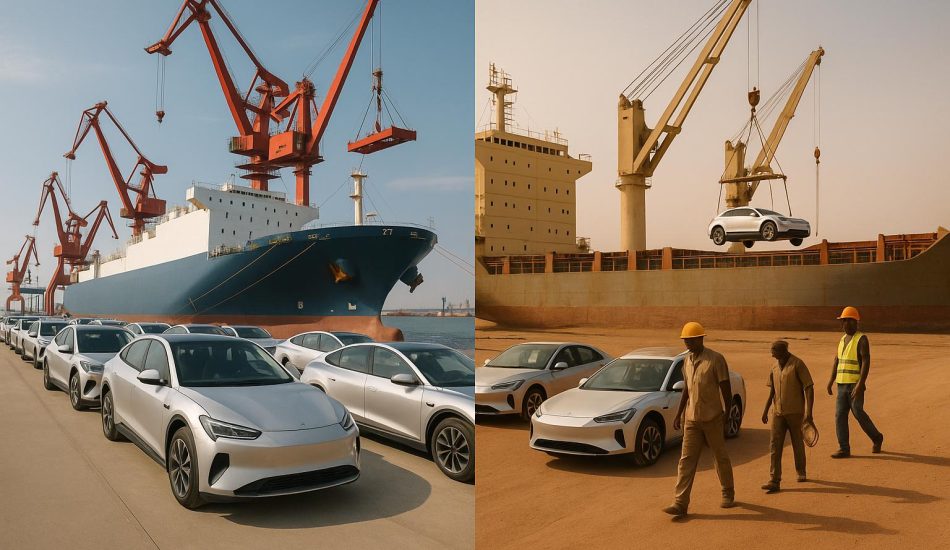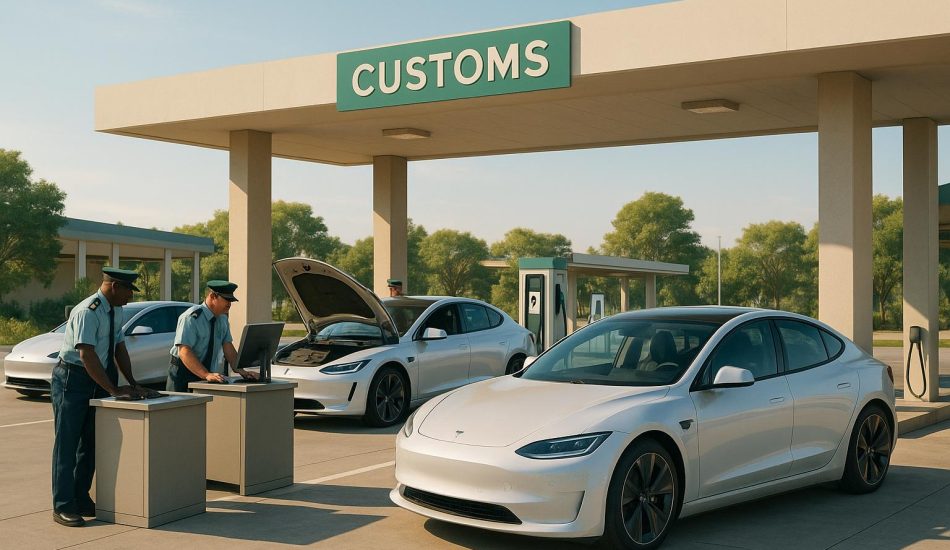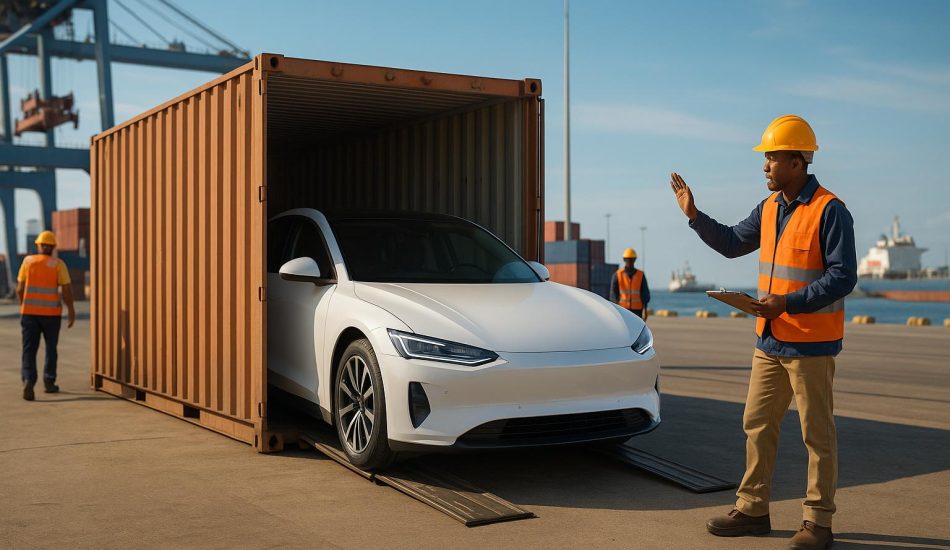
Kenya’s electric vehicle (EV) market is booming in 2025, with over 9,000 registered EVs as of May – up from just 2,694 in 2023. The government is driving this growth with tax breaks, including 0% excise duty, reduced import duties, and VAT exemptions, making EV imports more affordable. If you’re planning to import an EV, here’s what you need to know:
- Eligibility: EVs must be less than 8 years old, right-hand drive, and have at least 80% battery capacity.
- Costs: Import costs include VAT (16%), Import Declaration Fee (2%), and Railway Development Levy (1.5%). However, EVs benefit from 0% import duty.
- Process: Choose a compliant EV, complete pre-shipment inspections, work with a clearing agent for customs, and register with NTSA.
- Incentives: Tax exemptions and a growing charging network (200+ stations in 2025) reduce costs and improve usability.
Kenya’s push for EV adoption includes ambitious goals like 5% of all new registrations being electric by 2025 and long-term plans for 100% EV adoption by 2040. The time to import is now – this guide simplifies the process for you.
Kenya’s EV Market is EXPLODING in 2025! Here’s What You Should Know ⚡
Import Requirements and Eligibility
If you’re planning to import an electric vehicle (EV) into Kenya, there are specific rules and standards you need to follow. These regulations are in place to ensure safety, quality, and compliance with local guidelines. Here’s what you need to know about the eligibility criteria and required documentation.
Vehicle Age and Specifications
Kenya has strict rules regarding the age of imported vehicles. To meet the standards, your EV must be less than 8 years old from the date of manufacture or first registration. This ensures that the vehicle is equipped with modern safety features and has a battery life suitable for practical use. Additionally, the vehicle must have a right-hand drive configuration to align with Kenya’s traffic system. These measures aim to enhance road safety and reduce environmental impact.
Battery Health and Certification
The battery’s condition is a critical factor for EV imports. Imported EVs must have at least 80% battery capacity remaining. This requirement ensures the vehicle is still functional and reliable for everyday use. Certification from an authorized inspection agency, as mandated by Legal Notice No. 78 of April 28, 2020, is also required. This document will be part of the essential paperwork for clearing customs.
Pre-Export Inspection
Kenya operates a Pre-Export Verification of Conformity (PVoC) program to ensure vehicles meet the necessary standards before they leave the country of origin. If you’re importing a used EV from countries like Japan, the UAE, Thailand, Singapore, South Africa, or the UK, the vehicle must undergo mandatory pre-inspection by Quality Inspection Services Inc. (QISJ). Inspectors from PVoC agents will conduct the evaluations and issue a Certificate of Conformity (CoC). Without this certificate, customs clearance will be denied.
To avoid delays or unexpected costs, work closely with your supplier or export agent. Make sure they coordinate with the appropriate PVoC agents to get the inspection and certification done before shipment. This preparation can save you time and money during the import process.
Step-by-Step Import Process
Importing an EV involves three main phases, each with its own set of tasks and requirements.
Selecting the Vehicle and Verifying Documents
The first step is ensuring the vehicle you intend to import meets the basic criteria: it must be under 8 years old and configured for right-hand drive. When choosing your EV, work with trusted dealers or exporters. A good place to start is the Japanese Used Motor Vehicle Exporters Association (JUMVEA), which maintains a list of certified exporters. Always confirm an exporter’s credentials through JUMVEA membership and ask for references from past customers before making any commitments.
It’s also wise to check the specific model’s reliability and battery performance.
Gather all the necessary documents early in the process. These include the original commercial invoice, original bill of lading, import declaration form (IDF), original logbook from the exporting country, and your personal identification number (PIN) certificate. Customs authorities require original documents, so avoid relying on scanned copies.
Once you’ve secured the documents and verified their authenticity, you can move on to the pre-shipment inspection stage.
Pre-Shipment Inspection and Certification
Before shipping, your EV must undergo an inspection and certification process to ensure it meets Kenyan safety and quality standards. This is conducted under the KEBS PVOC Program (Pre-Export Verification of Conformity), which is managed by agents appointed by the Kenya Bureau of Standards (KEBS).
Since January 2015, KEBS has authorized SGS to oversee the PVoC program across 18 regions. To avoid penalties or entry denial at Kenyan ports, work with KEBS-approved agents to secure the necessary Certificate of Conformity (COC) and PVOC certificate.
The inspection process involves a physical check of the vehicle, testing of key components, review of production processes, and compliance verification with Kenyan standards. Ensure your exporter coordinates this process properly to avoid delays. Additionally, all documentation must adhere to the metric system for measurements, as required by Kenyan regulations.
Once the certification is complete, you can proceed with shipping, customs clearance, and registration.
Shipping, Customs Clearance, and Registration
With all certificates in hand, the next step is shipping the vehicle and completing customs clearance. The process for importing vehicles in Kenya is similar to that for other goods, but with specific requirements for automobiles.
It’s highly recommended to hire a licensed customs clearing agent to handle this phase. These agents will submit the necessary documents, coordinate inspections with port authorities, and manage the payment of duties and taxes on your behalf. According to the Kenya Revenue Authority:
"We have formulated procedures that are simple and efficient for you to import the motor vehicle you have dreamed of owning".
Your clearing agent will calculate taxes based on the vehicle’s customs value. For EVs, duties typically include 25% import duty, 10% excise duty, a 3.5% import declaration fee, and a 2% railway development levy. While a 16% VAT usually applies to vehicle imports, current government incentives waive VAT for electric and hybrid vehicles, offering significant cost savings.
After clearing customs, the final step is registering the vehicle with the National Transport and Safety Authority (NTSA). Registration can be completed through the eCitizen portal once customs clearance is finished. The NTSA will verify compliance with Kenya Bureau of Standards regulations before issuing the registration documents.
From shipping to final registration, the entire process can take several weeks. Factors like port congestion and document processing times may affect the timeline. Stay in close contact with your clearing agent to address any issues quickly and ensure your EV is delivered without unnecessary delays.
Costs and Taxes
Bringing an electric vehicle (EV) into Kenya comes with more expenses than just the purchase price. You’ll need to account for shipping, insurance, government fees, and professional service charges.
Cost Breakdown
The starting point for calculating your import expenses is the Customs Value (CIF). This figure combines the vehicle’s cost, insurance, and freight charges to Kenya.
Shipping and logistics make up a significant portion of the costs. For instance, port charges and Standard Gauge Railway (SGR) fees total around KES 120,000. Transporting your EV from the port to your final destination adds another KES 25,000.
Professional service fees are essential to navigate the intricate import process. Clearing agents, who handle customs paperwork, inspections, and tax payments, typically charge between KES 60,000–80,000. In more complex cases, fees can go up to KES 100,000.
Inspection and certification fees are mandatory. These include KES 15,000 for verification and another KES 15,000 for Interpol clearance. Additional charges include KES 2,000 for MVS, KES 1,000 for radiation inspection, KES 800 for an NTSA sticker, and KES 2,000 for the IDF.
Insurance costs depend on your EV’s value and the coverage you choose. Annual premiums typically range from KES 30,000–50,000, though rates can vary by provider and policy terms.
Registration with the National Transport and Safety Authority (NTSA) adds another KES 10,000–20,000 to your total. This step is necessary to legally drive your EV on Kenyan roads.
These costs lay the groundwork for your overall import expenses. Next, let’s dive into the taxes and levies that further shape the final price.
Taxes and Government Levies
Kenya’s tax system offers incentives for cleaner transportation options. The Kenya Revenue Authority (KRA) uses the Current Retail Selling Price (CRSP) to calculate import taxes, with the latest CRSP list effective from July 1, 2025.
Import duty is a major saving for EV importers. While traditional vehicles are taxed at 25% import duty, fully electric vehicles enjoy a 0% import duty rate. This exemption significantly reduces costs compared to importing gas or diesel-powered cars.
Excise duty applies at 10% of the Customs Value (CIF) for EVs. This tax applies to all vehicles, regardless of their energy source.
Value Added Tax (VAT) is calculated at 16% of the CIF value plus Excise Duty. This creates a compounding effect, as VAT applies to both the vehicle’s landed cost and the excise duty.
Other fees include the Import Declaration Fee (IDF), which is 3.5% of the CIF value, and the Railway Development Levy (RDL), adding another 2% of CIF. These charges support Kenya’s import infrastructure and railway projects.
Here’s an example of how taxes add up for a KES 700,000 EV:
| Tax Component | Calculation | Amount (KES) |
|---|---|---|
| Customs Value (CIF) | Vehicle + Insurance + Freight | 700,000 |
| Import Duty (0%) | 0% of 700,000 | 0 |
| Excise Duty (10%) | 10% of 700,000 | 70,000 |
| VAT (16%) | 16% of (700,000 + 70,000) | 123,200 |
| IDF (3.5%) | 3.5% of 700,000 | 24,500 |
| RDL (2%) | 2% of 700,000 | 14,000 |
| Total Taxes | Sum of all applicable taxes | 231,700 |
The Kenya Revenue Authority advises that actual import duty calculations can vary based on specific circumstances and regulations. It’s a good idea to confirm rates with KRA or consult a clearing agent before finalizing your plans. While online calculators can give you an estimate, the final costs might differ when completing the import process.
When planning your EV budget, keep in mind both the upfront taxes and ongoing costs like insurance renewals and registration updates. On average, the total cost of importing an EV ranges from 30–40% above the vehicle’s CIF value, factoring in all taxes, fees, and service charges.
sbb-itb-99e19e3
Government Incentives and Benefits
Importing electric vehicles (EVs) into Kenya comes with more than just cost considerations – government incentives play a key role in making EVs more affordable and supporting sustainable transportation.
Tax Reductions and Exemptions
Kenyan EV importers benefit from significantly reduced taxes: a 10% import duty (compared to up to 35% for conventional vehicles), full excise duty exemptions, and no standard 16% VAT. The Finance Bill 2025 reinforces these advantages by continuing VAT exemptions for electric motorcycles, bicycles, and buses.
"These tax breaks are aimed at making electric cars a viable alternative to petrol and diesel vehicles in the long run."
- James Mwangi, AutoMag.co.ke
These tax benefits are part of a broader strategy to make EVs more accessible and to encourage their adoption across the country.
Policies Promoting EV Adoption
Kenya’s push for electric mobility goes well beyond tax incentives. The government has set ambitious goals, including achieving 100% electric vehicle adoption by 2040 and ensuring that 5% of all newly registered vehicles are electric by 2025. The results are already visible: the number of registered EVs rose from 2,694 in 2023 to 9,047 by May 2025.
Infrastructure development is another key focus. Charging stations benefit from reduced electricity tariffs – $0.12 per kWh during peak hours and $0.058 per kWh during off-peak hours. Additionally, financial partnerships are helping make EV ownership more affordable through accessible financing options.
Kenya’s environmental goals align closely with its EV policies. The transport sector accounts for 11% of the country’s total CO₂ emissions and 67% of energy-related emissions. To address this, Kenya’s Nationally Determined Contribution aims to cut net CO₂ emissions by 32% by 2030. These efforts are supported by the country’s power grid, which now runs on 90% renewable energy as of June 2024.
Investment in the EV sector has also been significant. In October 2024, BasiGo secured a KES 5.43 billion ($30.5 million) investment from British International Investment (BII) and the U.S. Development Finance Corporation (DFC) to deploy 1,000 electric buses in Kenya and Rwanda over three years. Draft policies, such as the National E-Mobility Policy and proposed tax changes for unassembled EVs and motorcycles, further highlight the government’s dedication to advancing the EV ecosystem. Public-private partnerships are also expanding charging infrastructure by integrating charging points into commercial and public spaces.
These combined efforts demonstrate Kenya’s commitment to creating a supportive environment for EV importers, backed by forward-thinking policies and infrastructure development.
Compliance Tips and Common Pitfalls
Navigating Kenya’s import regulations requires strict attention to detail and thorough documentation. Any misstep can lead to delays, extra costs, or even customs rejection. By understanding common mistakes and following best practices, importers can make the process smoother.
Ensuring Documentation Accuracy
Kenya’s electronic customs system, Simba 2005, demands precision in documentation right from the start. Most importers rely on clearing agents to handle this part effectively, as even minor errors can cause significant issues.
Key documents include the Certificate of Conformity (CoC), issued by a Pre-Shipment Verification of Conformity (PVoC) agent for regulated products. For electric vehicles (EVs), the CoC confirms compliance with the Kenya Bureau of Standards’ requirements, ensuring your vehicle meets the necessary standards.
Another critical requirement is the Import Standards Mark (ISM), which is mandatory for all products sold in Kenya. This mark signifies that a product has been certified, and without it, your EV cannot legally enter the market.
Additionally, insurance must align with Kenyan licensing laws. Kenyan-based importers must use insurance companies authorized to operate in Kenya. Opting for international insurers not licensed in the country can halt the entire import process.
Once your documentation is in order, it’s equally important to avoid common mistakes that could derail your efforts.
Avoiding Common Mistakes
Even with accurate paperwork, certain pitfalls can complicate the import process. Here are some frequent issues and how to sidestep them:
- Meeting Kenyan Standards: Ensure the vehicle’s registration date (not the production year) and right-hand drive configuration comply with Kenyan regulations.
- Value Declaration Errors: Declaring the correct value of your EV is essential. Under-declaring to reduce duties may seem appealing, but it can result in hefty fines and long delays. The Kenya Revenue Authority verifies vehicle values using the Current Retail Selling Price, so accuracy is non-negotiable.
- Documentation Gaps: Importers often make errors in customs classification or submit incomplete paperwork. Electric vehicles have unique classification codes that differ from traditional cars, and mistakes here can lead to incorrect duties or processing delays.
- Inspection Timing Issues: Roadworthiness inspections, conducted by KEBS-appointed agents, must be completed in the export country before shipping. Attempting to arrange this inspection after the vehicle arrives in Kenya will result in rejection.
- Regulatory Changes: Customs laws and EV-specific regulations are updated frequently. Staying informed about these changes is critical to avoid unexpected challenges.
Given the complexity of Kenya’s import procedures, professional assistance can make a world of difference. Experienced clearing agents are well-versed in the electronic systems, documentation requirements, and potential stumbling blocks. By leveraging their expertise, you can navigate the process more efficiently and maintain compliance throughout your EV import journey.
Conclusion
Bringing an electric vehicle (EV) into Kenya in 2025 comes with appealing government incentives and a rapidly evolving market. Kenya’s electric mobility sector is gaining traction, presenting a promising opportunity for those interested in sustainable transportation solutions.
Current policies, combined with tax exemptions, significantly lower the cost of importing EVs. These measures are supported by government initiatives and advancements in renewable energy. For instance, as of June 2024, renewable energy made up 90% of Kenya’s power mix, providing a solid foundation for the growth of electric mobility. Tax breaks, including exemptions on VAT, import duty, and excise duty, further reduce the financial burden on importers.
The incentives don’t stop there. The Electric Mobility Association of Kenya (EMAK) has proposed bold fiscal measures, including full tax exemptions on EVs, batteries, and charging infrastructure. According to their "High Support" scenario, Kenya could see over 2 million EVs on its roads by 2040, potentially cutting more than 3.2 million metric tons of CO₂ emissions.
However, successful EV importation requires strict adherence to regulatory requirements. From ensuring the vehicle meets Kenya’s age and right-hand drive standards to obtaining the necessary Certificate of Conformity and Import Standards Mark, every step is crucial. Navigating Kenya’s electronic customs system can be complex, and staying updated on evolving regulations is essential. Professional clearing agents can be invaluable in simplifying this process and ensuring compliance.
Kenya’s supportive policies, growing charging infrastructure, and environmental benefits make EVs an appealing choice for both individuals and businesses. By following the outlined steps and working with experienced professionals, you can take full advantage of the available incentives while ensuring a smooth import process.
Cars Kenya: "Importing electric cars to Kenya opens up a world of environmental sustainability, cost savings, and superior driving experiences."
The momentum behind EV adoption in Kenya is building rapidly, and 2025 offers an excellent opportunity to join this shift toward cleaner, more sustainable transportation.
FAQs
What incentives does the Kenyan government offer to support electric vehicle imports?
The Kenyan government has rolled out a series of incentives to boost the adoption of electric vehicles (EVs) and make them a practical choice for more people. For starters, EV imports benefit from a reduced import duty of just 5%, which is half the usual rate. On top of that, EVs registered between 2016 and 2020 enjoy a 10-year exemption from motor vehicle tax.
There’s also a 50% cut in the base vehicle tax, calculated based on the weight of the EV. To encourage local manufacturing and assembly, grants are available to support businesses involved in EV production within Kenya.
These measures aim to lower costs, increase accessibility, and pave the way for cleaner transportation solutions across the country.
What steps should I take to ensure my electric vehicle qualifies for import into Kenya?
To import an electric vehicle (EV) into Kenya in 2025, your vehicle must meet a few key requirements. First, it needs to be no older than 8 years from the date it was manufactured. It also has to comply with the technical and safety regulations established by the Kenya Bureau of Standards (KEBS) and meet the Kenya Standard and Code of Practice for vehicle imports.
When planning your budget, don’t overlook the mandatory fees. You’ll need to pay a 25% import duty and a 10% excise duty, both calculated based on the vehicle’s retail price. These costs can add up, so it’s essential to account for them early on.
To avoid unnecessary delays or penalties, double-check that all your documentation is accurate and complete. Also, confirm that your EV meets all the required technical and regulatory standards before shipping. This preparation can save you a lot of hassle down the road.
What mistakes should I avoid when importing an electric vehicle to Kenya, and how can a clearing agent help?
When bringing an electric vehicle (EV) into Kenya, there are a few common pitfalls to watch out for. These include incomplete or incorrect documentation, misjudging taxes and fees, and not adhering to Kenyan import regulations. Such mistakes can result in expensive delays, penalties, or, in some cases, the shipment being turned away entirely.
Working with a clearing agent can make the process much smoother. They’ll ensure your paperwork is in order, assist with customs procedures, and guide you through Kenya’s specific import rules. Their knowledge can save you time, reduce stress, and help you avoid unexpected issues along the way.




